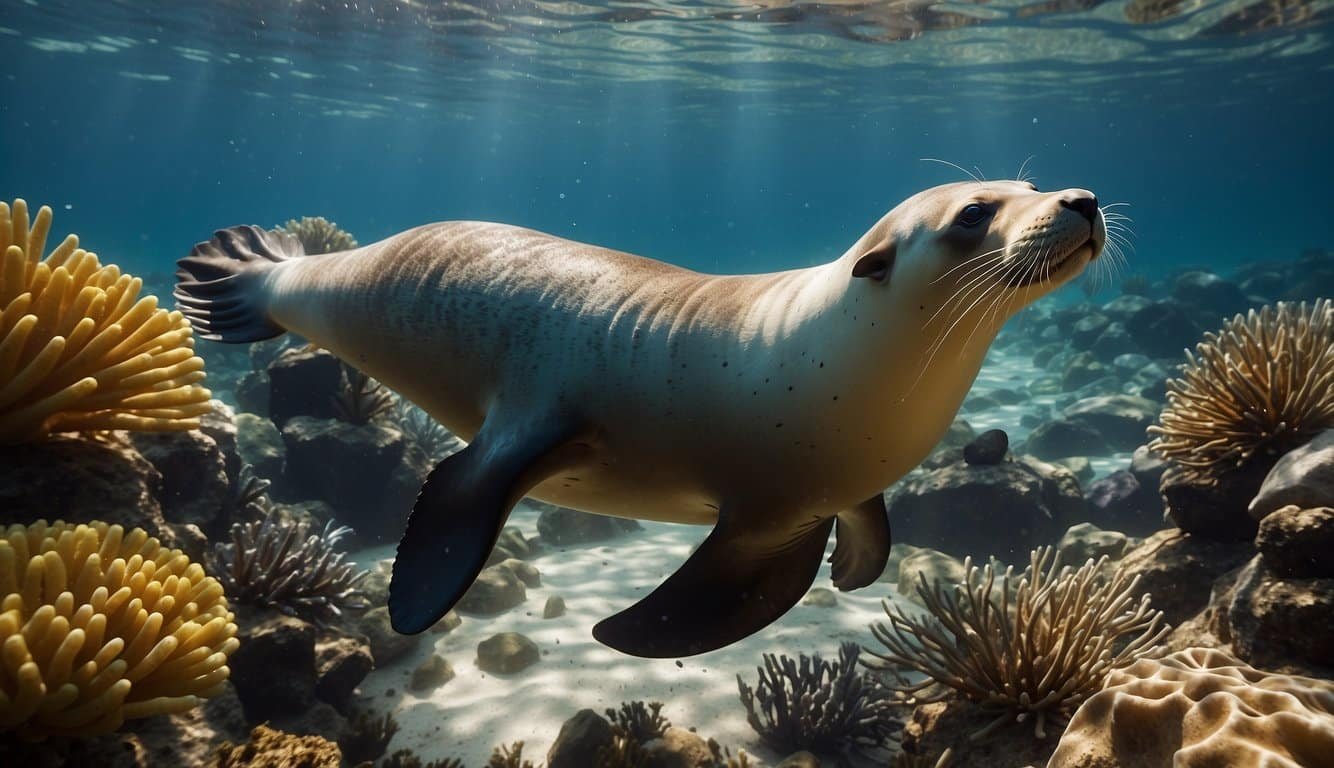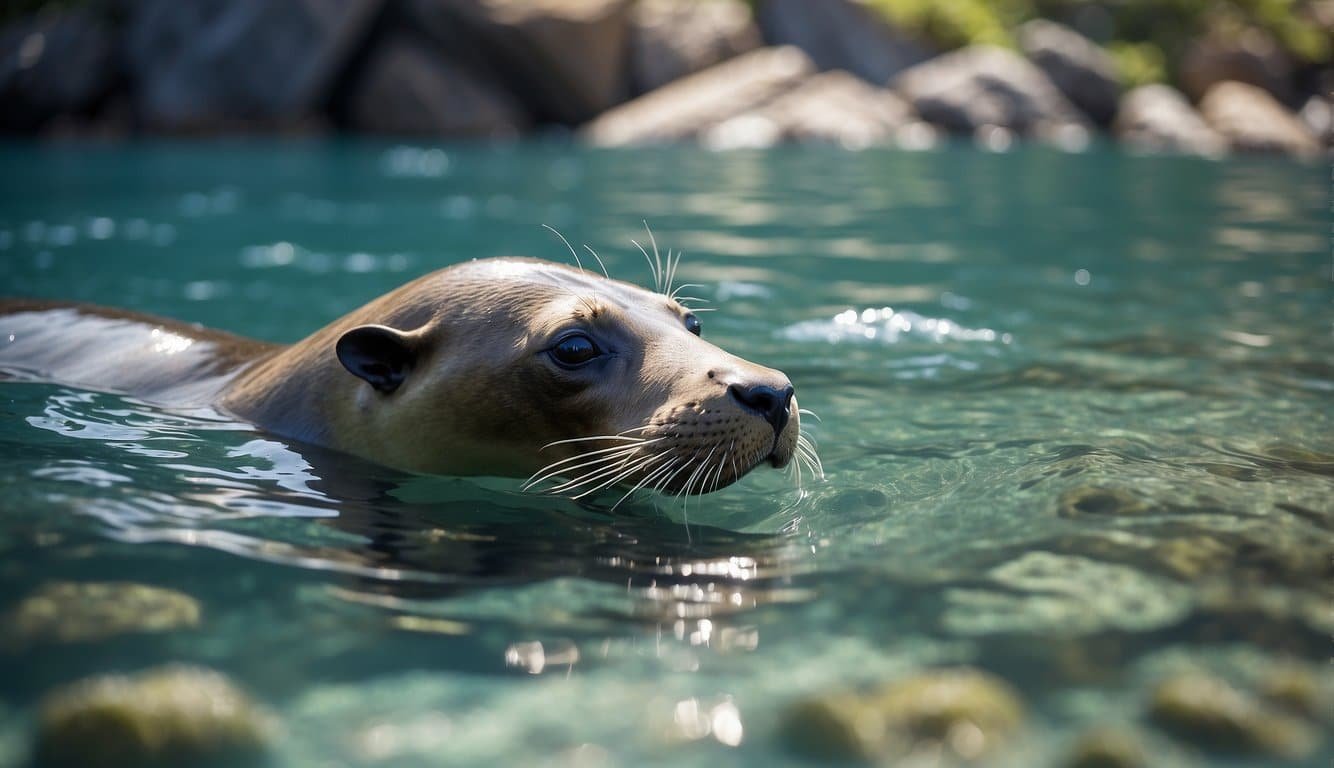Sea Lion Characteristics
Sea lions are fascinating marine mammals known for their playful nature and intelligence. These creatures exhibit a variety of distinct physical features and behaviors that reflect their adaptation to life in coastal and marine environments.
Physical Attributes
Sea Lions are known for their robust bodies covered with a layer of blubber, which helps them maintain body heat in cold waters. Adult sea lions vary in length and weight with some species reaching lengths of over 7 feet and weights of nearly 1,000 pounds. Distinguishing features include their external ear flaps and large, powerful foreflippers which they use for propulsion through water, while their hind flippers help steer. Their appearance is also characterized by a smooth, sleek coat that differs in coloration between species and sexes.
Taxonomy and Species
The family Otariidae, known as eared seals, includes several species of sea lions. This family is distinct from true seals due to the presence of ears. Within Otariidae, several genera are recognized such as Zalophus, which includes the well-known California sea lion (Zalophus californianus), and Otaria, encompassing species like the South American sea lion. Other notable species include the Australian sea lion (Neophoca cinerea) and the New Zealand sea lion (Phocarctos hookeri), each with unique characteristics.
Habitat and Distribution
Sea lions have a widespread distribution, occupying a plethora of habitats from the ice edges to the warm beaches of the Galápagos. They are primarily found in the Pacific Ocean, ranging from the coasts of Alaska to North America, as in the case of the Steller sea lion. Sea lions favor environments where they can haul out onto land or ice for rest and breeding. Accessibility to food sources also plays a crucial role in their distribution, as they frequently hunt for fish and squid in nearby waters.
Behavior and Ecology

Sea lions, captivating marine mammals and members of the pinniped family, exhibit a diverse array of behaviors and ecological roles in their habitats. From their hunting strategies to their complex social structures, there is much to explore about these intelligent creatures.
Diet and Hunting
Sea lions primarily feed on a diet of fish and squid, demonstrating refined hunting techniques. They have developed keen adaptations for their maritime life, with strong and agile bodies to pursue prey in the water. Their hunting behavior is not only pivotal for their survival but also influences the marine ecosystem around them.
Reproduction and Lifespan
These awe-inspiring mammals have a fascinating reproductive process, with a gestation period ranging from 11 to 12 months. After birth, sea lion pups are nurtured by their mothers, with adult females often seen on beaches nursing their young. The typical lifespan of sea lions can vary, but many live for around 20 years, with survival often dependent on the abundance of food and absence of predators or human interference.
Social Structure
Sea lions are known for their highly social behavior, forming large colonies on shorelines during the breeding season. Within these colonies, the establishment of hierarchies is common, with dominant males creating harems of females. The often heard barking sounds are a critical part of their communication, particularly when they are defending territory or establishing social bonds.
Conservation and Human Interactions

Sea lions’ interactions with humans range from conflicts with commercial fisheries to their role in aquarium exhibits, all within the context of conservation efforts to ensure their survival.
Threats to Survival
Sea lions face numerous threats that impact their survival. One of the primary concerns is the operational interactions with commercial fisheries, which can lead to both incidental catches and competition for food resources. Illegal hunting, although less common today, has historically reduced populations, and some species, like the Steller’s sea lion and the now-extinct Japanese sea lion, have been particularly affected. Pollution and habitat encroachment further exacerbate the risks for these marine animals.
Sea Lions in Captivity
Aquariums and zoos play a controversial yet vital role in the protection and understanding of sea lion species. While captive breeding programs have helped certain species like the California sea lion, which have been thriving in a human-dominated world, they also raise questions about animal welfare and the ethics of keeping wildlife in captivity. Education programs at these institutions aim to raise awareness and foster conservation efforts.
Historical Significance
The history of sea lions’ interaction with humans is both fascinating and somber. The now-extinct Japanese sea lion highlights the devastating effects of overhunting and the lack of early conservation efforts, while the recovery stories of other populations can teach important lessons about the resilience of species and the positive impact of human intervention when properly implemented. These animals have also been integral to local economies, and indigenous cultures have revered sea lions for millennia, adding to their historical significance.

